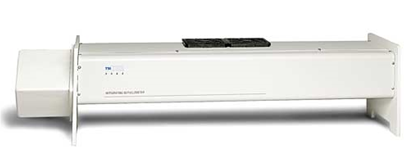 |
 |

| Home | Meet the Team | In The News | Aeronautics Research | Atmospheric Research | Instruments | Publications | Data |
|
||||||||||

|
||||||||||
| ||||||||||
|
Measuring Aerosol Optical Properties 
Aerosol optical properties include spectrally- and angularly-resolved scattering, absorption and extinction coefficients, which yield single-scattering albedos, angstrom exponents, and phase function. These parameters are needed for:
LARGE uses the following instruments to measure key optical properties.
Absorption Coefficients • Particle Soot Absorption Photometer (PSAP, Radiance Research) o Filter-based measurements at 470, 535 and 660 nm o Single sample and reference filters o Corrected for filter scattering using empirical procedures o Sensitivity < 1 Mm-1 o Sealed filter compartment, suitable for low-pressure operation o Flown on NASA aircraft in atmospheric composition studies since 1996 o http://www.esrl.noaa.gov/gmd/aero/instrumentation/psap_desc.html
• Tri-color Absorption Photometer (TAP, Brechtel Manufacturing, Inc.) o New instrument based on NOAA's Continuous Light Absorption Photometer (CLAP) o Operates similarly to PSAP, but has multiple sample and reference filter spots, advances automatically when filter transmission drops below threshold o Wavelengths and performance characteristics similar to PSAP o Sealed filter compartment, suitable for aircraft deployment o http://www.brechtel.com/products-item/tricolor-absorption-photometer/
• Three-Wavelength Photo-acoustic Aerosol Soot Spectrometer (PASS-3, DMT) o 405, 532 and 781 nm wavelengths o Sensitivity of ~5 Mm-1/sec for 781 nm channel, less for 405 and 532. o Susceptible to background noise and sample pressure fluctuations o Used primarily for lab studies and combustion source characterization o See: http://www.dropletmeasurement.com/products/airborne/PASS-3
• Multi-angle Aerosol Absorption Photometer (MAAP, Thermo-Scientific) o Reel-to-reel filter instrument similar to Magee Scientific Aethalometer o Red wavelength, 0.1 Mm-1 sensitivity for 2-minute average o Continuous measurement of black carbon and aerosol light absorption properties o Multiple detectors to simultaneously measure transmitted and scattered light o Transmission corrected for scattering using radiation-transfer algorithm o Filter does not seal, not suitable for use on aircraft o Used extensively in characterizing black-carbon emissions from aircraft
• 7-wavelength Aethalometer (AE-33, Magee Scientific) o Reel-to-reel filter-based instrument o Measurements at 370, 470, 520, 590, 660, 880 and 950 nm o Provides insight into brown-carbon absorption o Coefficients not corrected for filter scattering o Not suitable for low pressure operation, best for monitoring trends at ground stations o http://www.mageesci.com/images/stories/docs/aethalometer_ae33_specifications.pdf
• Liquid Waveguide Aerosol Absorption Spectrometer (under development at LaRC) o Based on approach pioneered by Rodney Weber at Georgia Tech o Particle-into-liquid-sampler (PILS) connected to a 1-m waveguide with a broad-band light source and spectrometer on each end o Wavelength range 350-700 nm o Includes 3 channels to measure background and buffer absorption o Designed for ground-based and airborne operation o http://www.atmos-chem-phys.net/10/5965/2010/acp-10-5965-2010.pdf
• Differential Photo-acoustic Absorption Photometer (ARI, Phase-II NASA SBIR project) o Single-wavelength o Designed for black-carbon measurements in combustion studies o Project to be completed by 2017
Scattering Coefficients • 3-Wavelength Integrating Nephelometer (TSINeph, TSI 3563) o Sensitive from 7 to 170 deg scattering angle; corrections applied for truncation errors o Detects total- and hemispheric back-scattering at 450, 550, and 700 nm o Precision of ~0.5 Mm-1 for 1 second average o Temporal response 1 sec o Works well at low pressure o Deployed on NASA aircraft for inflight measurements dozens of missions since 1996 o Used in combination with sample humidifier to measure f(RH) o http://www.tsi.com/integrating-nephelometer-3563/
• Single-Wavelength Nephelometer (RRNeph, Radiance Research M903) o Small unit suitable for ground and airborne applications o Detects scattering at 535 nm o Precision of ~0.5 Mm-1 for 5 second average o Not as stable as TSI units, thus mainly used for ground applications o http://www.esrl.noaa.gov/gmd/aero/instrumentation/RR_neph.html
• 3-Wavelength Integrating Nephelometer (APNeph, Air Photon, Inc) o Angular sensitivity from 7 to 170 deg o Detects total- and hemispheric scattering at 450, 532 and 632 nm o Suitable for use on ground and airborne platforms o Stated precision of 0.1 Mm-1 for longer averaging times o http://www.airphoton.com/nephelometers/
• Polarized Imaging Nephelometer (PINeph, provided by collaborator Vanderlei Martins, UMBC) o Measures aerosol phase function inside a closed chamber o Sensitivity down to Rayleigh scattering o Angular coverage from 1.5 to 178.5degs, with 0.5degs resolution o Included in LARGE instrument suite on DC3, SEAC4RS and DISCOVER-AQ o http://userpages.umbc.edu/~martins/laco/projects.htm
Extinction Coefficients • Cavity-Attenuated Phase-Shift Particle Extinction Monitor (CAPS PMex, Aerodyne) o Three separate units provide total extinction at 450, 530 and 630 nm o Precision of < 2 Mm-1 for 1 second average o Suitable for ground and airborne applications o Deployed on NASA Falcon during ACCESS II; used in a number of ground-based studies o NASA SBIR-funded project seeks to combine all three wavelengths in a single box o http://www.aerodyne.com/products/caps-pmex-monitor
• Spectral Aerosol Extinction Monitor (SpEx, developed by Carolyn Jordan, NIA/LARGE) o Long-path (39 m) extinction cell with fiber-optic couplings to broad-band source and spectrometer o Wavelength-range from 300 to 700 nm, with <1 nm resolution o Designed to provide information on brown-carbon absorption o Detection limit <20 Mm-1 for single scans o Successfully deployed onboard LARGE MACH-2 mobile laboratory during DISCOVER-AQ Colorado to measure spectral extinction from a variety of sources o Used in lab to characterize optical properties of aerosol and dust particles o Ongoing work by Dr. Jordan focuses on improving instrument precision and immunity to vibration and noise o For similar instrument see--http://scholars.unh.edu/chemistry_facpub/6/
|

|
Page Curator: Jay Madigan NASA Official: Bruce Anderson Page Last Modified: |
|
+ NASA Communications Policy + Freedom of Information Act + Budgets, Strategic Plans and Accountability Reports + Inspector General Hotline + Accessibility at NASA |
|
+ USA.gov + Open Government at NASA + Privacy Policy and Important Notices + Multimedia Browser Plug-ins |